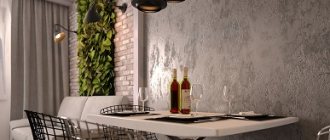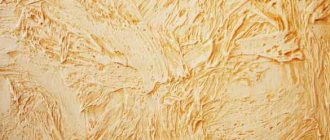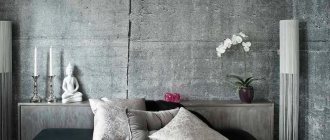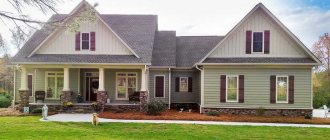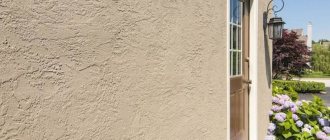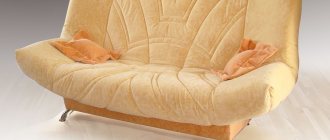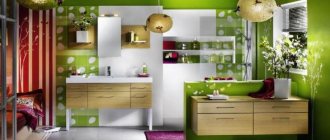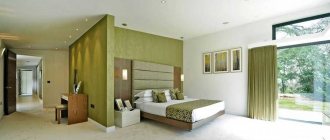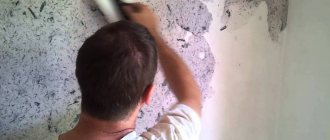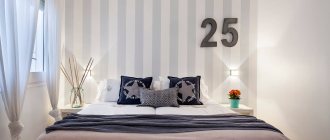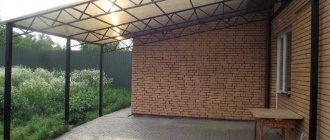Home » Type » House
HouseWall Decoration
Alyona
Decorative plaster of walls for the house “Bark beetle” has not in vain gained popularity among builders. Thanks to its clear textured pattern, an unlimited number of color options, shades, due to the play of light and shadow in the grooves, designers use it not only for plastering building facades, but also for decorating rooms. All types are discussed in more detail later in the article.
Features of the material
Before deciding on plastering work, you should know that “ Bark beetles” come on various bases:
- cement with polymer additives and stabilizers;
- acrylic;
- silicone;
- silicate (liquid glass).
Bark beetles have different bases
Manufacturers provide a choice of dry or ready-made mixtures in buckets with granule diameters from 1 to 3.5 mm. Cement-based bark beetle can be used not only for facades, but also for decorative work inside buildings. It has a number of advantages that you should pay attention to:
- durable, resistant to mechanical stress;
- frost-resistant;
- not afraid of water, snow, hail;
- inexpensive.
The material has many advantages
Disadvantage: dust accumulates in the grooves. Because of this, the facade loses its attractiveness. But it can be washed without fear of damaging or washing off the paint.
Due to its small thickness and light weight, it can be applied to any substrate, even polystyrene boards. Let's look at options and methods for applying this finishing material to building facades.
The larger the size of the granules, the greater the amount of plaster mixture needed per square meter.
Advantages and disadvantages of bark beetle plaster
Bark beetle plaster is durable and environmentally friendly. It contains only natural ingredients. Thanks to the mineral filler, the mixture turns out to be light - this, in turn, relieves the surface of the building from unnecessary load. Natural phenomena such as direct sunlight and low temperature do not have a significant impact on the material. Heavy rains, snow and hail will not damage the coating. Fire-resistant qualities also provide protection from sun exposure: the color retains its original brightness. In addition, plastered surfaces are easy to clean. It is acceptable to use water and detergents for these purposes. The bark beetle is resistant to mold formation - this is an important plus under any circumstances.
Note! This coating is difficult to damage mechanically, but if this has occurred, it will not be possible to hide the defects. The disadvantages are also the difficulty of application. An inexperienced person may need outside help.
Textured bark beetle plaster combines beautifully both with clinker tiles and with natural or artificial stone.
The advantages of this facing material are:
- the possibility of using bark beetle plaster for exterior and interior decoration;
- high viscosity and good adhesion of the material to the base, due to the presence of mineral additives and polymer materials in the mixture;
- environmental safety of the material;
- light weight of the surface formed by the facing material, which does not create additional load on the wall and foundation;
- has increased resistance to mechanical stress;
- the material does not shrink during the hardening process, which eliminates its cracking;
- has increased frost resistance, can withstand temperatures down to -55°C;
- the material is resistant to UV exposure and the influence of precipitation;
- able to withstand exposure to aggressive environments;
- has good vapor permeability, which allows the walls to “breathe” and prevents the formation of fungus and mold on the surface;
- possibility of easy painting with various paint compositions;
- long period of operation without loss of original appearance;
- fits well on brick, concrete, chipboard, plasterboard bases, sandwich panels and polystyrene boards, but requires the creation of a base layer based on cement or gypsum plaster;
- affordable price.
Note! It is not recommended to apply bark beetle plaster to wood, metal, plastic or glass surfaces.
Additional advantages of finishing the facade with bark beetle are:
- The material is available and widely distributed;
- There is a large selection of shades;
- Among other things, if the coating was originally white, it can be painted.
If you do not have the necessary skills for applying plaster, it is better to entrust the application of “bark beetle” to specialists.
Decorative bark beetle plaster is easy to paint, which is very convenient if there is a need to frequently renew the surface.
Decorative finishing of external walls
The plaster mixture is intended for finishing the following surfaces:
- brick;
- stone;
- concrete;
- old plaster.
Easy to apply to different surfaces
It is also used for finishing thermal insulation layers made of mineral wool, basalt wool, and polystyrene foam boards over a reinforcing mesh. The only condition for high-quality finishing is a flat surface. Any depressions and irregularities will not allow decorative grooves to be applied to the surface.
There are some nuances regarding coloring, which will be discussed below.
What is better, painting the entire solution at once or painting a plastered wall with paints?
When planning decorative work, you need to understand the advantages and disadvantages of both methods.
Color can be added directly to the solution only in polymer compositions. White cement-based bark beetle is best painted with water-based or acrylic paints after complete hardening. Theoretically, the first method is better. I plastered it once and forgot about it. But it's not that simple.
Subtleties of color choice
If to finish the facade you need to paint 4-5 bags of the mixture at once, then what size dishes are needed and where to get them? Only large construction organizations with the appropriate equipment can afford this. The second problem: how to calculate the exact amount of solution? What happens if one bucket is not enough? It is impossible to guess the exact shade right on the construction site. There is a risk of leaving a stain on the facade for many years.
In most cases, plastered walls are painted with water-based paints after hardening. Economically this is justified.
Preparing walls for applying bark beetle plaster
The beginning of any construction work involves choosing a material. To finish facades, you should use a coating with the addition of stone chips with a diameter of 2.5 mm or more.
The ideal option for interior decoration is a grain size with a fraction of 2 mm and even finer. You can get an accurate idea of the properties of the plaster by carefully studying the markings. The scope of its application depends on the indicators indicated there.
Different materials for surface treatment can be selected. However, the appearance of the pattern of the created bark beetle coating depends not on the composition, but on the type of application. Thus, the following varieties can be distinguished:
- a chaotic pattern, where a complex pattern is achieved by movements of a construction trowel that do not have a specific direction;
- circular patterns are obtained by applying material around a circle, with pre-conceived, identical magnitude and direction of actions;
- vertical application is carried out using up and down movements, and this is how the greatest resemblance to tree bark is achieved;
- a horizontal pattern is created according to the same principle, only the trowel work is carried out parallel to the floor.
Having chosen the required type of application, proceed to preparing the surface for coating. To do this, you need to carefully clean the surface, freeing it from dirt and dust, after which it is recommended to degrease the wall by treating it with a certain composition.
Next, all significant surface protrusions are removed with a spatula, and the recesses should be thoroughly puttied. If there is a need for this, it is worth insulating the wall, and a layer of thin polystyrene foam is the best material.
Comprehensive instructions about any type of plaster are located on each package of the finished mixture. Studying it and fulfilling all the described requirements guarantees obtaining a high-quality coating that can serve and delight with its external qualities for a long time.
When preparing the mixture yourself, it is better to make the composition with a reserve due to the difficulty of creating, in case of shortage, the desired shade, which is difficult to reproduce again. To obtain a certain range, it is convenient to use ready-made paste.
There are special tinting machines. They can help by selecting the required color and adding paste to the solution, creating the required amount of material sufficient for any repair. Such devices are often found in hardware stores.
Surface preparation
Preparation of stone, concrete, brick, and other surfaces for finishing is mandatory and requires careful execution. To do this, it is cleaned of dust and oil stains, the cracks are filled, and they are puttied with cement (for exterior) or gypsum mortar for interior work. Particular attention must be paid to searching for peeling old plaster. Such places must be removed and plastered again. clean the surface:
- manually with metal brushes;
- brushes mounted on a drill or grinder;
- sandblasting machine.
Cleaning the surface before work
If the walls are brick, stone, concrete, old, with sinks more than 3 cm deep, then a reinforcing mesh is pulled onto the surface. It is plastered with cement mortar, leveled, puttied, and primed.
Advice from experienced people:
- If an oil stain appears on the wall and it has not penetrated deeply, then it can be removed with a 3% solution of sulfuric acid. This is an ordinary electrolyte for filling batteries. You can buy it at an auto parts store. When diluting, it is necessary to pour the electrolyte into water, and not vice versa! If you confuse it, it is possible that sulfuric acid boils and splashes. This operation is best done with glasses;
- A primer for painting is required. If this is not done, overuse of paint is inevitable.
If necessary, the walls are plastered with cement mortar
Workflow Stages
Before starting work, you need to prepare your tools. You will need:
- a drill or hammer drill with an SDS shank for stirring the dry composition;
- wide stainless steel spatula (trowel) 30-40 cm wide for basic work;
- container for solution;
- a narrow spatula for applying the mixture in hard-to-reach places;
- plastic trowel for grouting;
- rollers and brushes for priming and painting;
- sprayer to soften dry areas.
You purchase a primer, putty with a certain granule size, colorants that provide the liquid plaster with the desired shade, or paint for painting dry plaster after finishing the work.
Full access must be provided to the surface intended for finishing. The furniture is moved aside, covered with plastic film, and the floor is protected from falling plaster.
Preliminary preparation
The surface is cleaned of dust and dirt using a vacuum cleaner or brush. Mold areas are disinfected with an antiseptic. Facades are prepared for finishing as follows:
- lay insulation from mineral wool or polystyrene foam;
- covered with a layer of glue;
- the surface is reinforced with plaster mesh;
- leveled with plaster or cement.
For outdoor work, mixtures with coarser grains are usually used. For interior decoration, use bark beetle putty with marble chips of a smaller diameter - 1.5-2.5. The surfaces are carefully leveled before applying the material:
- Beacons are placed on brick walls in places of unevenness, and leveling is carried out using plaster. Small depressions are sealed with putty.
- Seams on concrete surfaces are puttied to prevent cracks from appearing after finishing.
- The joints on the plasterboard bases are sealed, and a thin layer of putty is applied over the entire area.
- Walls coated with oil paint are sanded over the entire surface.
There is a rule: the maximum permissible curvature of the walls should not exceed the size of the bark beetle granules in the plaster.
Application of primer
The next stage of preparatory work is applying a primer to the entire area of the wall intended for plastering. The best compositions contain quartz sand. They penetrate deeply into the surface, reduce its water permeability, and improve the adhesion of materials. The primer is purchased in the same color as the putty, preferably from the same manufacturer.
The primer is applied in a thin layer using a foam rubber or fur roller, hard-to-reach areas are coated with a brush. Porous surfaces that actively absorb moisture are treated with a special paint with high penetrating ability. Work continues when the primer is completely dry (at least 12 hours must pass). In practice, the soil is left to dry overnight.
Preparation of the solution
The putty in the form of a dry mixture is pre-prepared. Take the amount of water indicated on the package at a temperature of 15-20˚C, and pour the putty into the liquid. The mixture is kneaded at the minimum speed of the drill in several steps lasting 5 minutes, achieving a uniform consistency of the material without lumps.
Bark beetle putty dries quickly. You should prepare an amount of solution that is guaranteed to be produced in 20-30 minutes. Paste-like putty in the same quantity is placed in a container for work, the bucket is hermetically sealed with a lid. Plastering is convenient for two people: one person applies a layer of putty with a wide metal spatula, the second follows with a plastic float and grouts it. In this case, you can not interrupt the process by plastering the entire surface.
Applying the mixture
There are general rules for applying bark beetle putty:
- the mass is applied to the edge of the trowel using a narrow spatula;
- the mixture is applied to the surface in an even thin layer (treated with acrylic compounds twice);
- It is advisable to carry out movements in one direction from bottom to top, or from right to left;
- when applying the solution there is no need to be afraid to apply a certain amount of force;
- putty is first applied to difficult areas, then the entire surface is plastered;
- It is advisable to do the entire wall in one go; if this is not possible, seal the edge with masking tape so that the edge does not harden;
- After the main application, they pass over the entire surface again, leveling the surface and removing excess.
Putty that has fallen on the floor cannot be reused!
How to remove old plaster?
It is necessary to remove old plaster only in case of poor adhesion to the base. You need to make sure what type of plaster is: cement or lime? Limescale must be removed without regret. If the cement holds tightly, there is no need to remove it.
Removing old plaster
Tip Check the quality by lightly tapping the wall with a hammer. If the sound is dull, it means the layer has fallen behind the brick base and will fall off over time. Such areas must be removed and plastered again.
Plaster is removed in two ways:
- manually with a chisel, hammer, scraper, spatula;
- mechanical hammer drill or grinder with a diamond wheel.
We resort to using a hammer drill
In both cases it is necessary to get to the base. The final stage is cleaning with metal brushes manually or with a grinder, removing dust with a wet cloth or vacuum cleaner.
Plaster mixture Bark beetle
Before starting plastering work, you must familiarize yourself with the manufacturers' recommendations for preparing the solution. Pay attention to the lifespan. That is, how long will the solution be plastic and workable. Please note that the recommendations indicate the approximate amount of water per kilogram of solution. Each batch may have some difference in the amount of water in one direction or another. Before starting work, you need to make a small amount of solution, a multiple of a kilogram, and weigh the amount of water.
The mixture must be stirred with a low-speed mixer or drill with a speed controller. After the first stirring, you need to leave it for 5 minutes to stabilize and stir again. Stir the mixture in such portions that you can use it completely.
Stir until desired consistency
In most cases, the survival time is about 3 hours. In order not to make a mistake with the amount of mortar and not to make too much, measure how much of it is needed per 1 m2 or how many square meters can be plastered with one bucket.
If the area is large, you will have to use several people. The iron rule of plasterers: one wall must be started and finished without interruption in work.
Advice When calculating the amount of mixture, rely on the manufacturer’s data, but be sure to add 5-10% in reserve.
Calculation of consumption of decorative plaster mixture
The putty is applied together with the fractions in the composition. Their size affects the material consumption: the larger the diameter of the particles, the more voluminous a layer must be applied. For finishing facades, larger fractions are used - from 3 mm. The average consumption of the mixture in such cases is about 3.5-4 kg per square meter. meter. If 2 mm fractions are used, the consumption will become much less - 2-2.5 kg per square meter. meter.
The thickness of the putty layer also depends on how smooth the facade is. For example, if we are talking about 10 square meters of wall with a “blockage” of several centimeters, then first you will need to install beacons at 3 points. Then the deviations for each of them are summed up, and the result is divided by the number of beacons (in this case, 3). The resulting indicator is the required thickness in centimeters. Paint consumption in kilograms is determined by multiplying the consumption rate indicated by the manufacturer by the above-mentioned value in centimeters.
Read the continuation of the article on the next page. To move to the next part of the article, use the page navigation numbers.
Pages: 1
Technology of applying facade plaster
There is nothing complicated about the application technology. The marble chips themselves will regulate the thickness of the application. To apply you must have:
- stainless steel grater or spatula;
- plastic grater.
Choosing material for work
When applying the solution, the metal float should be held at an angle of about 45 degrees. Each master chooses the angle of inclination for himself.
Adviсe:
- the solution should have such a consistency that it does not slide off the grater;
- the solution must be applied without effort;
- do not take breaks until you have covered the entire wall with the mixture;
- From time to time, check the readiness of the mixture for making indentations with a plastic grater from granules.
Drying time for the plaster mixture is at least two days.
After application, let dry
Composition consumption rates
Material consumption per sq. m of surface depends on a number of factors:
- size of fractions of marble chips (grains);
- curvature of walls;
- type of building material.
Each manufacturer produces a composition of a certain density. The main brands producing products: Ceresit, Volma, Dufa reibeputz, Prospectors. The cost of the mixture differs for each company. The approximate consumption of putty is indicated on the back of the package.
The table shows the increase in the amount of Ceresit putty with changes in grain diameter and depending on the evenness of the base.
| Fraction size (mm) | Material consumption in areas with minimal curvature (kg/m2) | Mixture consumption in the presence of joints and irregularities (kg/m2) |
| 2 | 2,0 | 2,2-2,4 |
| 2,5 | 2,5 | 2,9-3,3 |
| 3 | 3,2 | 3,6-4,0 |
| 3,5 | 3,5 | 4,0-4,5 |
| 4 | 3,8 | 4,2-4,7 |
Before purchasing the material, you need to calculate the surface area and decide on the brand of the mixture. Determine the required number of packages or buckets, increase the result by 10%.
Getting different effects
When the decorative plaster mixture begins to dry out, you can begin to apply the design. The marks are applied vertically, horizontally, at an angle or in a circular zigzag motion, trying to achieve a resemblance to the passages of a bark beetle in a tree.
Adviсe:
- if you start making vertical stripes from top to bottom, then you cannot change the direction to the opposite from bottom to top;
- the same goes for horizontal, circular and zigzag movements.
Under no circumstances do we change direction.
You can start drawing only after it dries. It is difficult to determine how much time is needed accurate to the minute. But there is one caveat. When the mixture dries, it decreases in volume, and small granules protrude above the surface. As soon as the grout stops clinging to the entire surface with its sole, you can begin.
"Rain Jets"
This is the simplest but most effective way of applying a pattern to the facade. It is done by vertically sliding a grater from top to bottom. The “length of the jets” is adjusted by the plasterer. Here you need to adhere to strictly vertical movements.
Method "Vertical rain"
The higher the house, the larger the size of the granules.
"Slanting Rain"
These are the same “Rain Jets” only from a certain angle. This effect is more complicated than the previous one because you must strictly adhere to the once chosen angle.
“Slanting Rain” Method
Before you start using this effect, you must first try it on a separate surface to decide whether this method of decoration is suitable for your object or not.
"Bark beetle"
This is the simplest effect, it is not difficult to perform. To do this, you need to move the plastic grater randomly in all directions.
Achieving the effect using grout
For home use, you should not take a mixture with granules smaller than 3 mm. Granules that are too small will not give a good visual effect at altitude. The grooves will be barely noticeable.
"Horizontal bark beetle"
Although such effects are most suitable for interior work, they are quite appropriate for implementing design ideas.
Horizontal option
When using this effect, the main condition is not to deviate too much from the horizontal.
Two-colored bark beetle
This is a more complex and expensive method of applying plaster in two shades. There are two ways to achieve this effect.
First. Adding color to the solution and preparing the colored base at the first stage. The next step is to paint the protruding surfaces with a different color using a short-nap roller.
The second method is to first paint the entire wall with a long-nap roller. It is necessary to ensure that all recesses (paths of the woodworm) are painted. At the second stage, the protruding surfaces are painted with a short-pile roller.
Use of two-color bark beetle
Thus, the recesses will be one shade, and the overall tone will be different.
For finishing the exterior of a house, “Bark Beetle” fits perfectly. It should be noted that when selecting shades for painting, there is a rule. No more than three colors should be used. In exceptional cases, four. Moreover, the fourth shade should be no more than 5% . These could be window frames, protective strips on the roof.
The foundation must be in harmony with the roof. If you cannot find a suitable foundation color that matches the roof, then use contrasting or neutral colors.
Harmony of foundation and roof
His Majesty neutral gray color harmonizes with almost all shades. See how the color scheme was chosen to decorate the walls of a residential building.
Pay attention to the almost complete match of the shades of the foundation with the roof. Painting the walls white and light green.
Classic design in three colors
There are a lot of options for choosing decorative solutions. After finishing the finishing work, impregnate the facade with a water-repellent composition. This procedure will protect the walls from the destructive effects of moisture and low temperatures for many years.
Bark beetle plaster: photo examples of successful use of the material
Bark beetle plaster is in wide demand due to its external qualities; it is a decorative plaster for the facade and interior of a house.
Note! Finishing made from this material has many advantages - it is durable, environmentally friendly and pleasant to look at. Its distinctive feature is its grooved texture.
Bark beetle plaster
The material has found widespread use throughout the world and remains one of the most sought after of its kind. There are two types of bark beetle on the market: acrylic and gypsum, and both of them are quite versatile in terms of application. To decorate walls yourself, you will need to purchase a considerable number of tools and materials for preparing surfaces, applying lower layers and the plaster itself. Then, after the initial stage of work and creating a base for the bark beetle, it remains to decide how exactly to design the coating. Special techniques have been developed for creating textured ornaments and decorative designs. At this stage it is also recommended to use your own imagination. The result can be a unique and stylish design.
Photos of textured bark beetle plaster clearly reflect this, and today it is one of the most popular and sought-after facing materials, which is easy to apply and can create not only a beautiful coating, but also protect the base from negative environmental influences and mechanical damage. You can learn more about this universal material from this article.
Interior decorative finishing of the house
Designers are looking for new ideas for interior decoration. “Bark beetle” is a textured plaster, characterized in that it:
- has a unique textured pattern;
- strong, durable;
- Can be repainted with different colors many times.
Great resistance to abrasion and the ability to wash walls from dirt make its use in rooms with a large number of visitors quite justified. Small pebbles of the same diameter create bizarre, unique grooves.
Interesting idea for interior decoration
Decorative stone-like plaster goes well with wood and drywall. Small sections of the wall or a completely plastered room with “Bark Beetle” is practical and modern. The use of matte paints, painting in two colors, creates an imitation of the bark of different types of wood. Acrylic or plaster compositions are suitable for decorating a bedroom, bath, children's or living room.
Manufacturers and reviews
Main manufacturers of decorative plaster "Bark beetle":
- Knauf.
- Ceresite.
- Bergauf.
- Baumit
- VGT.
- Bayramix.
- Dufa.
- De Luxe.
Bark beetle coating is produced by many companies, but it is better to purchase from trusted and well-known ones. It is important to choose only from the category available to you at a price. You can keep track of promotions, discounts and sales, or order material delivered by mail. Another option is to buy from a hardware department store.
- Review #1.
For a very long time my husband and I tried to choose plaster for cladding the balcony. After walking around the stores, we came up with the idea of reading about interior finishing options from well-known manufacturers. The unusual design in the “Bark Beetle” style immediately caught my eye. The solution seemed very original to us. When we gave our balcony the desired look, we decided to use the same option for tiling the kitchen. We are pleased with the result. - Review #2.
I thought for a long time about what material to choose for plastering the facade of the house. There were options to purchase a dry mixture, but I was afraid of not maintaining the proportions when mixing the composition and getting the wrong result. I took the ready-made mixture and did not regret it at all. Although the “Bark Beetle” plaster cost me more, I didn’t have to worry about the result of the painting. I really liked the final image of the facade. The putty went on very smoothly and beautifully. For work I used a spatula and a trowel. After completing the process, I carefully applied it with a soft bristled roller. Excellent result.
Decorative plaster "Bark beetle" is suitable for facing work indoors and outdoors. Before choosing a finishing mixture, you should carefully read the instructions and follow the recommendations of specialists.
Peculiarities
For interior work, the industry offers ready-made mixtures:
- acrylic;
- silicate;
- silicone;
- polymer cement.
Only polymer-cement compositions are sold in dry form. They must be prepared before use. To do this you need a low speed mixer, a bucket, and water. The main condition for high-quality plaster is a clean and smooth wall. To work, you need a stainless steel float and plastic grout.
It is important that the wall is level
Hallway decoration
To create a unique interior, it is not necessary to plaster the entire room. It is enough to select one or more walls. In order for the room to look aesthetically pleasing, it is necessary to remember that the “Bark Beetle” is not suitable for every style. For a small hallway, you should take into account the following: vertical stripes make the room higher, and horizontal stripes lower.
Tip When selecting colors, try to use no more than three. The hallway is where guests find themselves. In most cases, it does not shine with large areas and natural light. Therefore, when decorating the hallway, it is recommended to use warm pastel colors: beige, light brown, light orange.
Try to choose colors that are not too bright
Decorating the hallway in the “Loft” style
This style of room decoration seems primitive, but in terms of design costs it is one of the most expensive. The more the room resembles a workshop or utility room, the cooler the design. The texture of the wall with deep grooves is what the Loft lacks.
A room that looks more like a utility room
Bathroom finishing
This plaster mixture is very resistant to wet conditions and its use for bathroom decoration is quite justified. But it should be remembered that “Bark beetle” is not a ceramic tile. The bathroom should have good ventilation. The walls must be completely dry after moistening.
A good combination of shades for the bathroom
When plastering, consider the material of the base of the walls: stone, concrete, brick or plasterboard. If the walls are plasterboard, they must first be plastered with cement mortar over a reinforcing mesh. The bathroom has many plumbing fixtures plated with chrome or nickel . Therefore, the Techno style is best suited. Walls covered in two tones using metallic shades will highlight the Techno style in the bathroom.
Bark beetle in the bedroom
In order to make an original bedroom design, it is enough to plaster one of the bedroom walls in a minimalist style.
Minimalist style for the bedroom
Advice To decorate rooms inside a building, it is recommended to use acrylic, silicone or silicate plasters, which are ready for use immediately in buckets. You just need to add color and stir gently.
Silicone is the most expensive, but its performance qualities offset the high price . After drying, the surface becomes shiny and will last for decades.
Chalet style bedroom
Unusual, practical and affordable
To decorate a bedroom in a rustic style, it is enough to decorate one wall with a textured layer. The bark beetle will come in handy in this case.
The rustic style is characterized by:
- a lot of wood;
- stone;
- textured plaster;
- fireplace.
The wall made of stone blocks near the fireplace looks interesting, the surface of which is eaten away by a bark beetle . Local lighting of the surface will cast fancy shadows, emphasizing the relief structure.
In the living room
The living room is the central room in the house. Family gathers here for the holidays and receives guests. This room should be a source of pride for the owners. Smooth, white walls have long been out of fashion. The textured surface of the walls will help add zest to the design of the room.
A highlight in the design of the living room
Pay attention to the use of local lighting to accentuate the plastered wall. The living room should have a festive look, so it is recommended to paint it in two colors. When painting, there are two options: the base color is light or dark. It all depends on taste. The second color should be contrasting to the first.
Tip: To focus the attention of guests on some art object, decorate a small panel in the center of the wall. Here you can hang a bright painting or photograph and the living room in the art deco style is ready.
Examples of small and large rooms
Bark beetle plaster in the corridor also has a right to exist. The corridors in the apartments are not very wide. Sometimes it is difficult for two family members to stretch in a narrow space. There is always a risk of rubbing yourself against the wall. The bark beetle is so strong that repeated touching is of no use to it.
Tip To keep this small room looking fresh all the time, leave some paint after finishing and touch up worn areas on the walls from time to time.
Decoration of the staircase
This is the structure you get if you combine horizontal and vertical movements. To obtain a more vivid effect, it is necessary to use mixtures with filler with a diameter of at least 3.5 mm.
How to apply bark beetle
Ease of work is one of the main advantages of bark beetle, because such plaster is easy to apply yourself. But first you will have to prepare the surfaces: remove old paint, sand, clean. Prime the walls or treat them with special antiseptics to prevent fungus.
Patch up large defects on the surface with ordinary gypsum putty. You don’t have to strain yourself too much here, because the bark beetle will hide minor flaws. If the difference in height along the wall is too large, it is better to level it, otherwise the textured coating will only emphasize it.
Apply an acrylic primer as the first layer for strong adhesion and elimination of excess moisture. The recommended thickness of the bark beetle layer corresponds to the filler fraction. During the process, this can be seen visually as soon as the first furrows begin to appear. Use a special grater or spatula at an angle of 60 degrees.
For façade finishing, the preparation is slightly different, so first you need to lay a reinforcing mesh on the insulation. Wait a day for it to stick firmly, and only then proceed to priming and plastering.
Remember that textured plaster sets quickly, so you need to work quickly and without interruptions. Do not apply the mixture to any old coating - it is not durable. And don’t do finishing if the temperature is below 5 degrees.
Depending on how you distribute the plaster, you will get different patterns. These can be vertical or horizontal stripes, chess, frost, cork and others. The bark beetle takes up to 3 days to dry, depending on humidity and temperature.
If you want to paint the top of the plaster, you need a textured roller with fine pile, for example, made of velor. It will get into all the furrows well, so you don't even need to press hard. And with multiple shades, you can create a vibrant two-tone paint job just by varying the roller pressure.
The role of lighting to enhance decorative effects
When using “Bark Beetle” for decorative wall decoration, no matter where it is located outside or inside, do not forget about lighting. Lighting can be:
- general (chandelier in the living room);
- local (floor lamps, sconces);
- accent (swivel lamps that focus attention on the object).
By using lower light from lamps located on the floor, you can achieve two-level illumination of the object of interest.
Lighting niches and openings plastered with bark beetles allows you to highlight the opening and add volume to the room. Hidden light illuminating an interesting art object adds mystery to the design.
Some tips:
- to increase the volume of the room, direct the light from the lamps to the walls;
- to make the ceiling higher, remove the chandelier from the center of the room and place the lamps around the perimeter;
- the use of sconces adds volume to the room;
Add volume to the room through lighting
Using lighting to create an original design, you can hide imperfections, expand or reduce the size of the room, and focus attention on objects that are important to the owners:
- photos;
- paintings;
- vases;
- antique objects.
Lighting is a powerful design tool to create a stylish interior without resorting to major renovations for little money.
What is a bark beetle
This type of cladding gets its name from wood-eating bark beetles that live under the bark and gnaw grooves of varying depths and locations on the surface of the tree. The name of the plaster does not imply a specific composition of the mixture, but the technology of execution. The surface plastered with bark beetle imitates the work of a grinder beetle.
The effect is achieved by adding marble chips, particles of titanium dioxide, and other durable grains of mineral origin to the mixture. The larger the additive fractions, the more prominent and deeper the grooves on the surface are. Its consumption depends on the grain size of the bark beetle plaster.
Cladding walls with bark beetle requires skill and skill. However, it is quite affordable to do this work yourself, saving a significant amount. You need to follow the advice of experts and choose an inconspicuous wall in the corridor, toilet or balcony for your first experiment.
Combination of colors in the interior
The fact that color affects mood and physiological functions of a person has been proven by scientific research. Before you start plastering rooms with Bark Beetle, you need to take into account the color effect of the furniture and other objects in the room. Of course, personal taste preferences will play a major role, but the advice of scientists should also not be neglected. This issue has been studied for a long time; there are special color combination tables for designers.
Shade combination table
The first color is dominant, and the rest are complementary, harmoniously combined with the main one.
Textured plaster in its appearance resembles stone, so designers use it in those styles where stone materials are required.
Preparing the mixture
The following types of plaster are used to decorate walls using bark beetle technology:
- High-quality silicone containing natural resins;
- The most expensive are silicate ones, based on liquid glass;
- The cheapest and most practical cement-based mineral;
- Acrylic - very convenient to use, but poorly resistant to sunlight.
Bark beetle putty, purchased in the form of a dry powder with the addition of solid particles, is diluted with water before application. To do this, take a large container so that the hand with the tool can fit into it when working. Water temperature 20°–23°. It is better to mix with a construction mixer or a drill turned on at medium speed.
Acrylic bark beetle plaster is sold ready-made, painted in various colors. If it is white, you can add the desired color and stir. Important! All other bark beetle mixtures cannot be tinted . They are poorly and unevenly painted; a large amount of dye can reduce the quality of the material.
